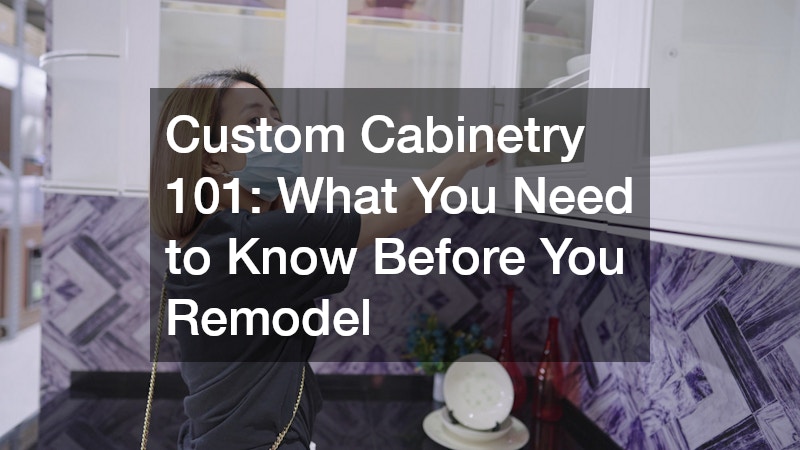Custom Cabinetry 101 What You Need to Know Before You Remodel
Remodeling a home can be an exciting yet overwhelming endeavor. One of the most impactful upgrades you can make is investing in custom cabinetry. Beyond mere storage, well-designed cabinets can define the style, functionality, and value of your home.
However, diving into a cabinetry project without proper knowledge can lead to costly mistakes and long delays. This guide will walk you through the essential aspects of custom cabinetry, helping you make informed decisions before you start your remodel.
Understanding Custom Cabinetry
Custom cabinetry refers to cabinets that are designed and built specifically for your space, rather than mass-produced in standard sizes. Unlike stock or semi-custom cabinets, which are readily available in pre-set dimensions and finishes, custom cabinets offer complete flexibility in design, materials, and hardware. This means every aspect, from the wood type to the door style and drawer configuration, can be tailored to your needs.
The advantages of custom cabinetry are numerous. First, you gain the ability to optimize storage solutions for awkward or unique spaces. For example, a corner cabinet with pull-out shelves or a pantry that extends to the ceiling can make a room far more functional. Second, you have control over quality. Premium materials and craftsmanship often translate into cabinets that last decades longer than stock options. Finally, custom cabinetry allows homeowners to match or complement existing décor perfectly, ensuring a cohesive and polished look throughout the home.
Choosing Materials and Finishes
One of the most important decisions in a cabinetry project is selecting the right materials and finishes. Wood is the most popular choice, with options ranging from oak and maple to cherry and walnut. Each species has distinct grain patterns, hardness levels, and color tones. It’s worth considering not only aesthetics but durability—especially in high-use areas like kitchens and bathrooms.
Beyond wood, there are engineered products such as MDF and plywood, which offer cost-effective alternatives with stable performance. These materials can be painted or veneered to achieve the look of natural wood without the price tag.
Finishes also play a critical role in both style and maintenance. Solid stains can enhance the natural grain of wood, while paints offer a wide variety of colors to match your design vision. Matte, satin, and gloss finishes each provide different visual effects and ease of cleaning. Hardware finishes—such as brushed nickel, brass, or matte black—also influence the overall aesthetic and should be selected to complement the cabinetry’s design.
Planning Your Layout
A successful custom cabinetry project begins with thoughtful planning. Start by assessing your storage needs and how you use the space. In the kitchen, for example, consider the “work triangle” concept—placing the sink, stove, and refrigerator in a practical arrangement that reduces unnecessary steps. Custom cabinets can be designed to enhance workflow, with features such as pull-out trays, spice racks, or built-in recycling bins.
In bathrooms, consider maximizing vertical storage with tall cabinets or wall-mounted options. Laundry rooms benefit from cabinets above machines or counters that hide detergents and cleaning supplies, while providing a seamless look.
Accurate measurements are crucial. Even minor errors can result in costly adjustments later. Take detailed measurements of walls, doors, windows, and ceiling heights. It’s also wise to account for appliances and plumbing, ensuring that cabinets fit perfectly without interfering with functional elements.
Working With a Cabinet Maker
Choosing the right professional is as important as choosing the cabinets themselves. A skilled cabinet maker can transform your ideas into reality, offering guidance on materials, finishes, and design features that enhance both beauty and utility. When selecting a cabinet maker, review their portfolio, ask for references, and discuss timelines and budgets upfront.
Communication is key. Provide clear expectations about style, function, and quality. Some homeowners prefer to provide sketches or inspiration images, while others rely on the cabinet maker’s expertise for design suggestions. Most professionals will create detailed renderings or 3D models to help you visualize the final product before construction begins.
Budgeting is another consideration. Custom cabinetry typically costs more than stock or semi-custom options, but the investment often pays off in longevity, satisfaction, and resale value. Be upfront about your budget and ask for a detailed breakdown of costs, including materials, labor, and installation fees.
Remodeling with custom cabinetry can dramatically elevate the style, organization, and value of your home. By understanding the options, planning your layout carefully, selecting the right materials, and working with a reputable cabinet maker, you can ensure a smooth and successful project. While the process requires time and investment, the rewards are long-lasting—creating a space that is not only functional but uniquely tailored to your lifestyle. With careful preparation and informed decision-making, your custom cabinetry remodel can become the centerpiece of your home renovation, combining beauty, utility, and lasting quality.







